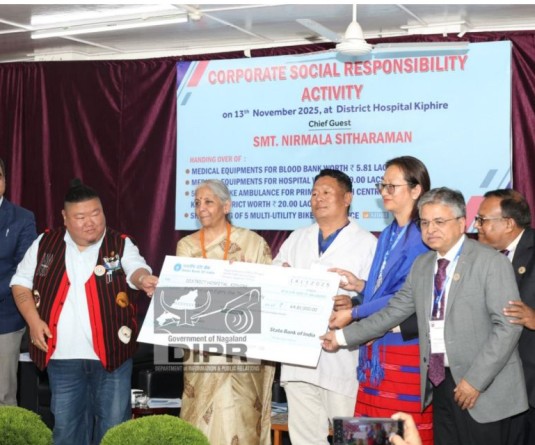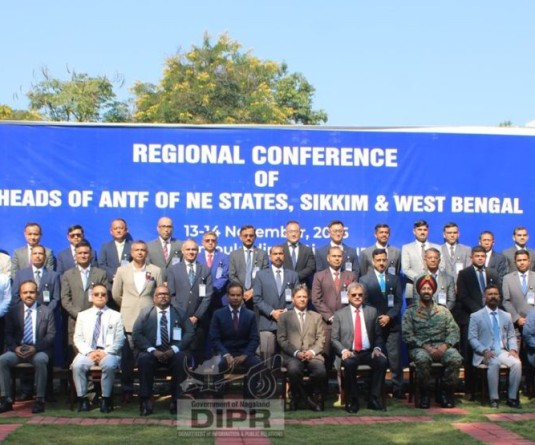
• State has only 52.04 % forest cover remaining
• Only 2.20 % is owned by the government
• Village owned forests constitute 45 %
Our Correspondent
Kohima | March 31
From the State’s geographical area of 16,579 sq. km, forests occupy an area of approximately 8629 sq. km that is 52.04 percent, the Department of Environment, Forests and Climate Change in its annual administrative report 2017-2018 has stated. Out of the 52.04 percent area, Government owned forests comprise of only 2.20 percent, and government controlled (private owned) forests consist of 5.98 percent, while the village owned forests constitute 45 percent.
The State faces a number of challenges and threats to wildlife management, according to the report. They include - habitat fragmentation due to commercial logging or due to human settlement, poaching for bush meat for commercial and personal purposes, public apathy, carrying capacity, bushfire, shifting cultivation, landholding pattern of the State, unscientific and unplanned development activities from centrally sponsored schemes and no resources from the State government.
To conserve wildlife and forest management, the Department is maintaining wildlife in Intangki National Park, Singphan Wildlife Sanctuary, Puliebadze Wildlife Sanctuary and Fakim Wildlife Sanctuary. To increase Protected Area, the State Government notified 18 villages as Community Reserve namely Kigwema, D. Khel Kohima, Mezoma, Dihoma, Chishilimi, Khekiye, Lizuto, Atoizu, Thsuruhu, Tsekhewelu, Luzaphuhu, Kikruma, Chemekong, Morakjo, Tsiepama Community Reserve, Khrokhropfu, Mopungchuket and Bonchu.
A recent report of the India State of Forest Report (ISFR) 2017 which was released in February also revealed that the forest cover in Nagaland State has decreased by 450 sq km since 2015.
As per the report, which is a biennial publication of the Forest Survey of India (FSI), the maximum decline of green cover in the state pertained to ‘Open Forest’ (OF). This declined by 342 sq km since 2015.
In terms of districts, Tuensang registered the maximum decrease of forest cover since the last assessment (99 square kilometers). Tuensang was followed by Mon (59 sq kms), Phek (57 sq kms), Kiphire (53 sq kms), and Kohima (39 sq kms). Dimapur registered zero change in forest cover.
The reasons for the decline in Nagaland’s forest cover were however summed up in just one sentence by the report. The ISFR 2017 attributed shifting cultivation and developmental activities as the main cause.
Budgetary allocation
In budgetary allocation section of the annual report, the State plan is projected as ‘nil.’ There is no explanation given. There are two proposed assistance from the Central Zoo Authority of India for Nagaland Zoological Park, Rangapahar (for construction of white tiger enclosure and enrichment enclosures) where a total of Rs 1,45,17,000 is being proposed, and Blyth’s Tragopan Breeding Centre, Kohima for the continuity of breeding Blyth’s Tragopan) with a total of Rs 1,53, 91,000. However the funds for both projects are yet to be released.
On Centrally Sponsored Schemes which is in the ratio of 90:10 between the centre and the state, two schemes have been projected - Project elephant (35 lakh) and Integrated Development of Wildlife Habitat (656.556 lakhs) out of which, the report said, Rs 516.15 has been released. However, the report also remarked that “These funds are awaited for release by the State Government.”
Nagaland Forest Management Project-JICA
Japan International Cooperation Agency (JICA) signed an agreement with the Government of India to provide Official Development Assistance (ODA) loan of 6,224 million Japanese Yen (approximately Rs 400 crore) for "Nagaland Forest Management Project."
The loan program was signed on March 31, 2017 and covers 185 villages in all the 11 districts of the State with a total proposed area of 79,096 hectares of land. The project is for ten years starting from April 1, 2017 to March 3, 2027. The total project cost is 8,534 million Yen, out of which Japan International Cooperation Agency (JICA)’s share is 6,224 million Yen and the State government’s share is 2310 million Yen.
The share of the State government is in the form of Administration cost, that is salaries of the staff. The repayment period is 30 years and it will commence once the project is completed. As a special category state, the reimbursement will be done on a formula of 90:10 with 90 percent borne by the Government of India and 10 percent by the Government of Nagaland, the annual administrative report stated.
The main objective of the project is to improve forest eco-system and support income generation by rehabilitation of Jhum area and provision of livelihood support, contributing to sustainable forest and environmental conservation and livelihood improvement in the target villages in Nagaland State.
The project has three components- Forestry interventions and biodiversity conservation; Livelihood improvement and community development and Institutional strengthening.






